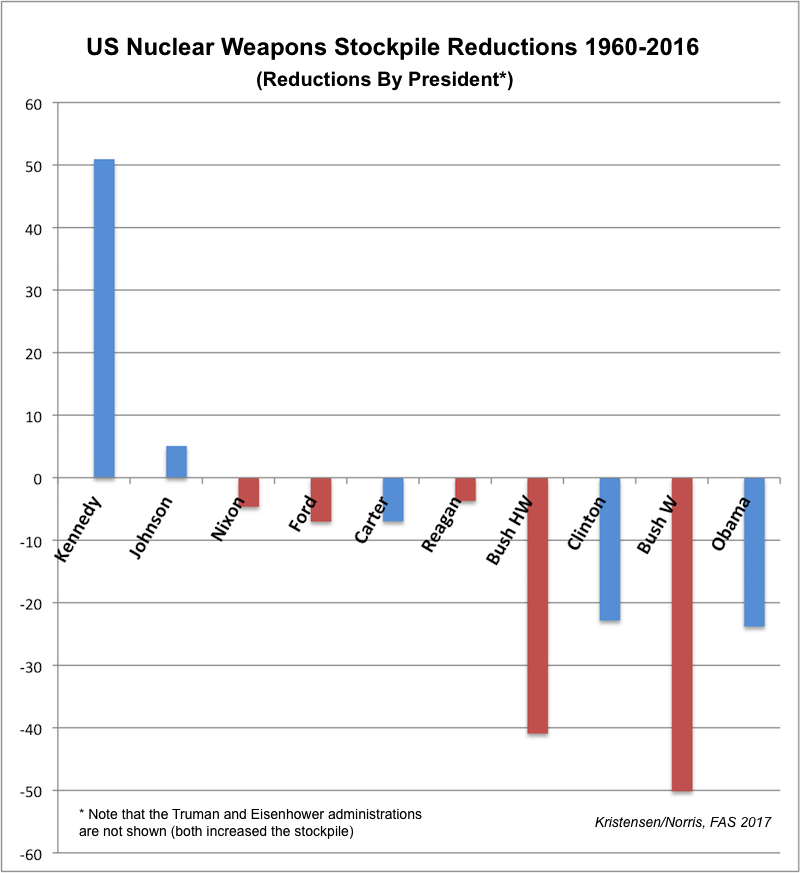In Reuters Interview President Trump Flunks Nuclear 101
President Donald Trump in an interview with Reuters today demonstrated an astounding lack of knowledge about basic nuclear weapons issues.
According to Reuters Trump said he wanted to build up the US nuclear arsenal to ensure it is at the “top of the pack.” He said the United States has “fallen behind on nuclear weapons capacity.”
Building up the US nuclear arsenal would be an unnecessary, unaffordable, and counterproductive move. It is unnecessary because the US military already has more nuclear weapons than it needs to meet US national and international security commitments. It would be unaffordable because the Pentagon will have problems paying for the nuclear modernization program initiated by the Obama administration. And it is counterproductive because it would further fuel nuclear buildups in other nuclear weapon states.
The claim that the US has “fallen behind on its nuclear weapons capacity” is also wrong; the US has the nuclear weapons capability it needs to meet its national and international security commitments. All nuclear-armed states have different nuclear weapons capacities depending on their individual needs. Nuclear planning is not a race but a strategy.
In terms of capacity, the United States is already at the “top of the pack” with highly capable nuclear forces that are backed up by overwhelming conventional forces. See here how the US nuclear arsenal compares with other nuclear-armed states.
Trump also called the New START Treaty “a one-sided deal” and a “bad deal.” Once again he is wrong. The treaty has equal limits for both the United States and Russia: by February 2018, neither side can have more than 1,550 warheads on 700 deployed launchers and no more than 800 total deployed and non-deployed launchers.
Next month the new bi-annual aggregate data set will be published; the previous one from September 2016 showed Russia with 1,796 warheads on 508 launchers compared with the United States with 1,367 warheads on 681 launchers.
Some people got very excited about that saying the larger number of Russian deployed warheads somehow gave Russia an advantage and showed they didn’t intend to comply with the treaty. Warheads can be moved on and off launchers relatively quickly; the important number is the number of launchers where the US was counted with 173 more than Russia.
Indeed, according to the Pentagon and Intelligence Community, Russia “would not be able to achieve a militarily significant advantage by any plausible expansion of its strategic nuclear forces, even in a cheating or breakout scenario under the New START Treaty…” (Emphasis added.)
But nitpicking about numbers misses the bigger point: the New START treaty was signed with overwhelming support from the US military, Congress, former officials, and experts because the treaty caps the nuclear forces of both countries and continues an important on-site verification system and data exchange.
President Trump may have been briefed by the Pentagon on his role in the nuclear war plan. But his latest interview with Reuters shows that he urgently needs to be briefed on the status of US nuclear forces, other nuclear-armed states, and the basics of the arms control treaties the United States has signed. But that briefing needs to be done outside the White House bubble and include bi-partisan and independent input. Otherwise all indication are that President Trump will be extraordinarily poorly equipped to make informed decisions about the nuclear policy.
Additional resources:
This publication was made possible by a grant from Carnegie Corporation of New York and Ploughshares Fund. The statements made and views expressed are solely the responsibility of the author.
In Reuters Interview President Trump Flunks Nuclear 101
President Donald Trump in an interview with Reuters today demonstrated an astounding lack of knowledge about basic nuclear weapons issues.
According to Reuters Trump said he wanted to build up the US nuclear arsenal to ensure it is at the “top of the pack.” He said the United States has “fallen behind on nuclear weapons capacity.”
Building up the US nuclear arsenal would be an unnecessary, unaffordable, and counterproductive move. It is unnecessary because the US military already has more nuclear weapons than it needs to meet US national and international security commitments. It would be unaffordable because the Pentagon will have problems paying for the nuclear modernization program initiated by the Obama administration. And it is counterproductive because it would further fuel nuclear buildups in other nuclear weapon states.
The claim that the US has “fallen behind on its nuclear weapons capacity” is also wrong; the US has the nuclear weapons capability it needs to meet its national and international security commitments. All nuclear-armed states have different nuclear weapons capacities depending on their individual needs. Nuclear planning is not a race but a strategy.
In terms of capacity, the United States is already at the “top of the pack” with highly capable nuclear forces that are backed up by overwhelming conventional forces. See here how the US nuclear arsenal compares with other nuclear-armed states.
Trump also called the New START Treaty “a one-sided deal” and a “bad deal.” Once again he is wrong. The treaty has equal limits for both the United States and Russia: by February 2018, neither side can have more than 1,550 warheads on 700 deployed launchers and no more than 800 total deployed and non-deployed launchers.
Next month the new bi-annual aggregate data set will be published; the previous one from September 2016 showed Russia with 1,796 warheads on 508 launchers compared with the United States with 1,367 warheads on 681 launchers.
Some people got very excited about that saying the larger number of Russian deployed warheads somehow gave Russia an advantage and showed they didn’t intend to comply with the treaty. Warheads can be moved on and off launchers relatively quickly; the important number is the number of launchers where the US was counted with 173 more than Russia.
Indeed, according to the Pentagon and Intelligence Community, Russia “would not be able to achieve a militarily significant advantage by any plausible expansion of its strategic nuclear forces, even in a cheating or breakout scenario under the New START Treaty…” (Emphasis added.)
But nitpicking about numbers misses the bigger point: the New START treaty was signed with overwhelming support from the US military, Congress, former officials, and experts because the treaty caps the nuclear forces of both countries and continues an important on-site verification system and data exchange.
President Trump may have been briefed by the Pentagon on his role in the nuclear war plan. But his latest interview with Reuters shows that he urgently needs to be briefed on the status of US nuclear forces, other nuclear-armed states, and the basics of the arms control treaties the United States has signed. But that briefing needs to be done outside the White House bubble and include bi-partisan and independent input. Otherwise all indication are that President Trump will be extraordinarily poorly equipped to make informed decisions about the nuclear policy.
Additional resources:
This publication was made possible by a grant from Carnegie Corporation of New York and Ploughshares Fund. The statements made and views expressed are solely the responsibility of the author.
Obama Administration Announces Unilateral Nuclear Weapon Cuts
By Hans M. Kristensen
The Obama administration has unilaterally cut the number of nuclear weapons in the Pentagon’s nuclear weapons stockpile to 4,018 warheads, a reduction of 553 warheads since September 2015.
The reduction was disclosed by Vice President Joe Biden during a speech at the Carnegie Endowment for International Peace earlier today.
This means that the Obama administration during its two terms has reduced the US nuclear weapons stockpile by 1,255 weapons compared with the size at the end of the George W. Bush administration – a number greater than the estimated number of warheads in the arsenals of Britain, China, France, India, Israel, North Korea, and Pakistan combined.
Stockpile Reductions In Context
The Obama administration’s additional unilateral cut shows up as a small dip on the graph of US nuclear weapons stockpile changes since 1945 (see figure below; graph corrected Sep 2017).
Even so, the Obama administration still holds the position of being the administration that has cut the least warheads from the stockpile compared with other post-Cold War presidencies.
Part of the reason for this is that the overall size of the stockpile today is much smaller than two decades ago, so one would expect new warhead cuts to also be smaller. But this is only partially true because the George W. Bush administration cut significantly more warheads from the stockpile than the Clinton administration.
In fact, it is still the case that Republican presidents in the post-Cold War period have cut many more warheads from the stockpile than have Democratic presidents: 14,801 versus 4,437.
Even so, the latest cut means that the Obama administration has managed to surpass (barely) the Clinton administration in terms of how much it reduced the stockpile (24 percent versus 23 percent) (see figure below).
Reducing the Hedge
The administration has not disclosed what types of warheads were cut from the stockpile or what part of it they were taken from. We estimate that the warheads were taken from the inactive reserve of non-deployed warheads that are stored to provide a “hedge” against technical failure of a warhead type or to respond to geopolitical surprises.
The 2013 Nuclear Employment Strategy determined that the hedge was too big and that it was only necessary to hedge against technical warhead failure. That hedge would also serve as a geopolitical hedge. As a result, several hundred hedge warheads were no longer needed.
So the 553 cut warheads probably include excess W76, B61, and B83 warheads that were scheduled to be retired anyway as a result of changes to the nuclear war plans and the ongoing warhead life-extension programs. [Update 011317: In addition to excess W76s, the cut might also include the W84 warhead that previously armed the Ground Launch Cruise Missile. The W84 was retired once but brought back into the stockpile as a potential warhead candidate for the LRSO. But after the W80 was selected as the LRSO warhead, the W84 might have met its doom (House conservatives tried to prohibit dismantlement of the W84 in the FY2017 defense bill but the effort didn’t survive the final cut). Yet there were fewer than 400 W84s produced, so the 553 cut (“almost 500 warheads for dismantlement on top of those previously scheduled for retirement”) would have to include other warhead types as well. Those could potentially also include excess W78 ICBM warheads. Any potential B61s would likely be minimal because they await production of the B61-12.]
The Growing Dismantlement Queue
The cut adds significantly to the large inventory of retired (but still intact) warheads that are awaiting dismantlement. Secretary of State John Kerry announced in April 2015 that the retirement queue included some 2,500 warheads. Vice President Biden announced that the number has since grown to about 2,800 warheads.
Biden also announced that the Obama administration during its eight years in office had dismantled 2,226 warheads. That indicates that about 250 warheads were dismantled in the last year.
The administration has promised that all the warheads that were retired prior to 2009 will be dismantled by 2021 (in reality some warheads already dismantled were retired after 2009). But with the average rate of about 278 warheads dismantled per year during the Obama administration, it will take until 2026 to dismantle the current backlog of retired warheads.
Political and Strategic Implications
The Obama administration must be congratulated on taking additional steps to unilaterally reduce the US nuclear weapons stockpile and improve its nuclear arms reduction legacy.
This will help the US position at the Preparatory Conference for the nuclear Non-Proliferation Treaty (NPT) later this spring and will increase pressure on the other nuclear-weapons states party to the treaty (Russia, China, France, and Britain) to also take new initiatives – even without formal arms negotiations.
The Obama administration also deserves praise for continuing to provide transparency of the US nuclear arsenal. Not only has it disclosed the history of the US nuclear stockpile and provided annual updates. It has also disclosed its warhead dismantlement history and declared how many retired warheads remain in the dismantlement queue. And it has declassified other chapters of the US nuclear history, including the number of nuclear weapons deployed at sea during the Cold War.
This transparency helps facilitate a debate about the history and future of nuclear weapons that is based on facts rather than rumors. Moreover, it helps increase the incentive for other nuclear-armed states to also be more transparent. If Britain and France were also to disclose their nuclear stockpile and dismantlement histories, the three Western nuclear powers would have a significantly stronger position from which to urge Russia and other nuclear-armed states to be more transparent about their arsenals.
At home, the Obama administration’s announcement about the additional nuclear cuts helps shine the light on the Trump administration and what its nuclear policies will be. Some will decry the Obama administration’s unilateral cut as weakening US military strength, but that would be wrong for several reasons.
First, the Obama administration has started a nuclear weapons modernization program that makes the George W. Bush administration pale in comparison.
Second, the cut reflects US military requirements. The Pentagon has long stated that even after the New START treaty is implemented next year, the United States will still have up to one-third more nuclear warheads deployed than is needed to meet US national and international commitments.
Russia currently has a nuclear weapons stockpile of nearly 4,500 warheads but is also reducing its nuclear arsenal (despite a temporary increase in deployed warheads counted under New START). While some commentators are obsessed with US-Russian nuclear parity, the Pentagon seems less interested in numbers and more interested in quality and in 2012 concluded:
The “Russian Federation…would not be able to achieve a militarily significant advantage by any plausible expansion of its strategic nuclear forces, even in a cheating or breakout scenario under the New START Treaty, primarily because of the inherent survivability of the planned U.S. Strategic force structure, particularly the OHIO-class ballistic missile submarines, a number of which are at sea at any given time.”
Instead, the Trump administration should continue the broad outline of the Obama administration’s nuclear policy of gradually but responsibly reducing the numbers and reliance on nuclear weapons while actively seeking to persuade other nuclear-armed states to follow the example.
Additional Information:
- United States nuclear forces, 2017 [Note: this publication was researched before the 2017 stockpile announcement.]
- Global Overview: Status of World Nuclear Forces
This publication was made possible by a grant from the New Land Foundation and Ploughshares Fund. The statements made and views expressed are solely the responsibility of the author.
France’s Choice for Naval Nuclear Propulsion: Why Low-Enriched Uranium Was Chosen
This special report is a result of an FAS task force on French naval nuclear propulsion and explores France’s decision to switch from highly-enriched uranium (HEU) to low-enriched uranium (LEU). By detailing the French Navy’s choice to switch to LEU fuel, author Alain Tournyol du Clos — a lead architect of France’s nuclear propulsion program — explores whether France’s choice is fit for other nations.
https://issuu.com/fascientists/docs/france_s_choice_for_naval_nuclear_p
Pakistan’s Evolving Nuclear Weapons Infrastructure

Pakistan’s tactical NASR nuclear-capable mobile rocket launcher now appears to be deployed.
In our latest Nuclear Notebook on Pakistani nuclear forces, Robert Norris and I estimate that Pakistan has produced an estimated stockpile of 130-140 nuclear warheads for delivery by short- and medium-range ballistic missiles, cruise missiles, and fighter-bombers.
Pakistan now identifies with what is described as a full-spectrum nuclear deterrent posture, which is though to include strategic missiles and fighter-bombers for so-called retaliatory strikes in response to nuclear attacks, and short-range missiles for sub-strategic use in response to conventional attacks.
Although there have been many rumors over the years, the location of the nuclear-capable launchers has largely evaded the public eye for much of Pakistan’s 19-year old declared nuclear weapons history. Most public analysis has focused on the nuclear industry (see here for a useful recent study). But over the past several years, commercial satellite pictures have gradually brought into light several facilities that might form part of Pakistan’s evolving nuclear weapons launcher posture.
This includes 10 facilities, including 5 missile garrisons (soon possibly 6) as well 2 (possibly 4) air bases with fighter-bombers.

Pakistan’s nuclear weapons related infrastructure includes at least 10 major industrial facilities and about 10 bases for nuclear-capable forces. Click map to view full size.
The nuclear warheads that would arm the launchers are thought to be stored at other secure facilities that have not yet been identified. In a crisis, these warheads would first have to be brought to the bases and mated with the launchers before they could be used.
Security at these and other Pakistani defense facilities is a growing concern and many have been upgraded with additional security perimeters during the past 10 years in response to terrorist attacks.
There are still many unknowns and uncertainties about the possible nuclear role of these facilities. All of the launchers are thought to be dual-capable, which means they can deliver both conventional and nuclear warheads. So even if a base has a nuclear role, most of the launchers might be assigned to the conventional mission. Further analysis in the future might disqualify some and identify others. But for now, this profile of potential road-mobile launcher garrisons and air bases are intended as a preliminary guide and accompany the recent FAS Nuclear Notebook on Pakistani nuclear forces.
Nuclear-Capable Road-Mobile Missile Launcher Bases
The total number and location of Pakistan’s nuclear-capable missile bases is not known. But analysis of commercial satellite photos has identified features that suggest that at least five bases might serve a role in Pakistan’s emerging nuclear posture. This includes army garrisons at Akro (Petaro), Gujranwala, Khuzdar, Pano Aqil, and Sargodha. A sixth base at Bahawalpur (29.2829, 71.7955) may be under construction. There is also a seventh base near Dera Ghazi Khan (29.9117, 70.4922), but the infrastructure is very different and not yet convincing.
An obvious difficulty in identifying nuclear missile bases is that the infrastructure is not yet publicly known, that commercial satellite photos do not have sufficient resolution to positively identify nuclear-capable launchers with certainty (especially smaller shorter-range types), that all launchers are dual-capable (not all bases with a certain launcher may have a nuclear role; and not all nuclear-capable launchers at a particular base may be assigned nuclear warheads), and that Pakistan (like other nuclear-armed states) most likely is engaged in considerable efforts to conceal and confuse identification of nuclear launchers.
With these caveats, here is a description with images of what we consider to be the five primary nuclear-capable bases and the primary TEL (Transporter Erector Launcher) production facility in Pakistan:
Akro Garrison: This base is located (25.5483, 68.3343) approximately 18 km (11 miles) north of Hyderabad between Akro and Petaro in the southern part of the Sindh Province approximately 145 kms (90 miles) from the Indian border. The garrison covers an area of 6.9 square kms (2.7 square miles) and has been expanded significantly since 2004 (the base was first pointed out to me by Martin Bulla, a German amateur satellite imagery enthusiast). The Akro Garrison includes a unique underground facility located under what appears to be a missile TEL garage complex. The underground facility consists of two star-shaped sections located along a central corridor that connects to two buildings with covered access ramps. The six TEL garages appear to be designed for 12 launchers.
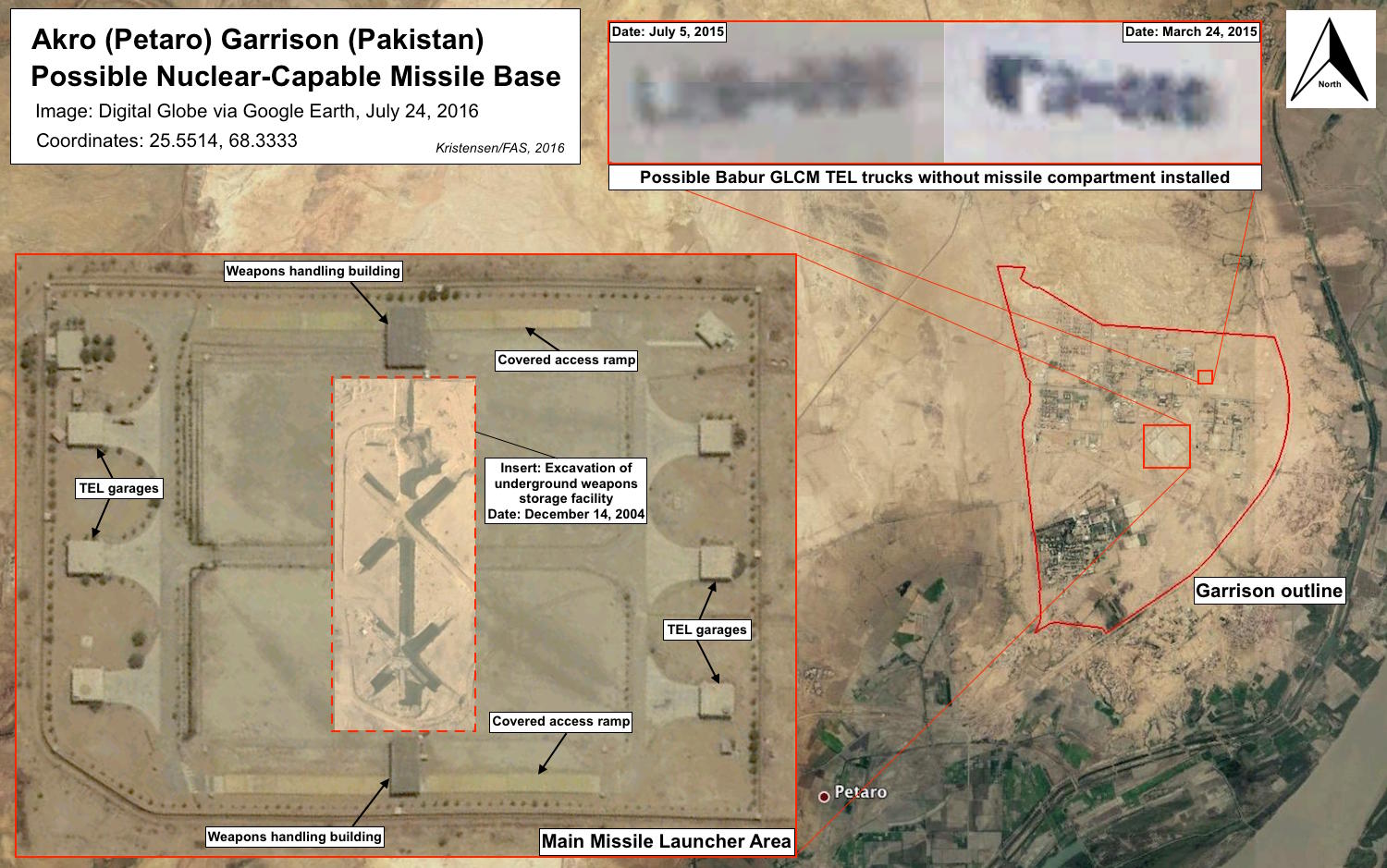
The Akro Garrison has a TEL area with unique underground facility.
It is not possible to identify the suspected launchers in the TEL complex from the available photos. But analysis of a vehicle training area in the northeast corner of the garrison shows what appears to be five-axel TELs for the Babur cruise missile weapon system.
In a hypothetical crisis the launchers presumably would load their complement of missiles at the base and disperse outside to predetermined launch locations in the region. The range of the Babur is uncertain; NASIC reports it as 350 km (217 miles) while the Pakistan government claims a range of more than 500 kms (373 miles), sometimes as much as 700 kms (435 miles). The Akro unit would be able to defend all of the southeastern part of Pakistan, including Karachi.
Gujranwala Garrison: This sprawling base complex covers an area of approximately 30 square kms (11.5 square miles) and is located (32.2410, 74.0730) in the northeastern part of the Punjab Province approximately 60 kms (37 miles) from the Indian border. Since 2010, the base has added what appears to be a TEL launcher area in the western part of the complex. There is also what appears to be a technical area for servicing the launchers. The TEL area became operational in 2014 or 2015. The TEL area appears to be made up of two identical sections (each consisting of launcher garages, a weapons loading hall, and a weapons storage igloo), each similar in design to the TEL area at Pano Aqil. The security perimeter appears to have room for a third TEL section. (This and other facilities have also been spotted by https://twitter.com/rajfortyseven.)
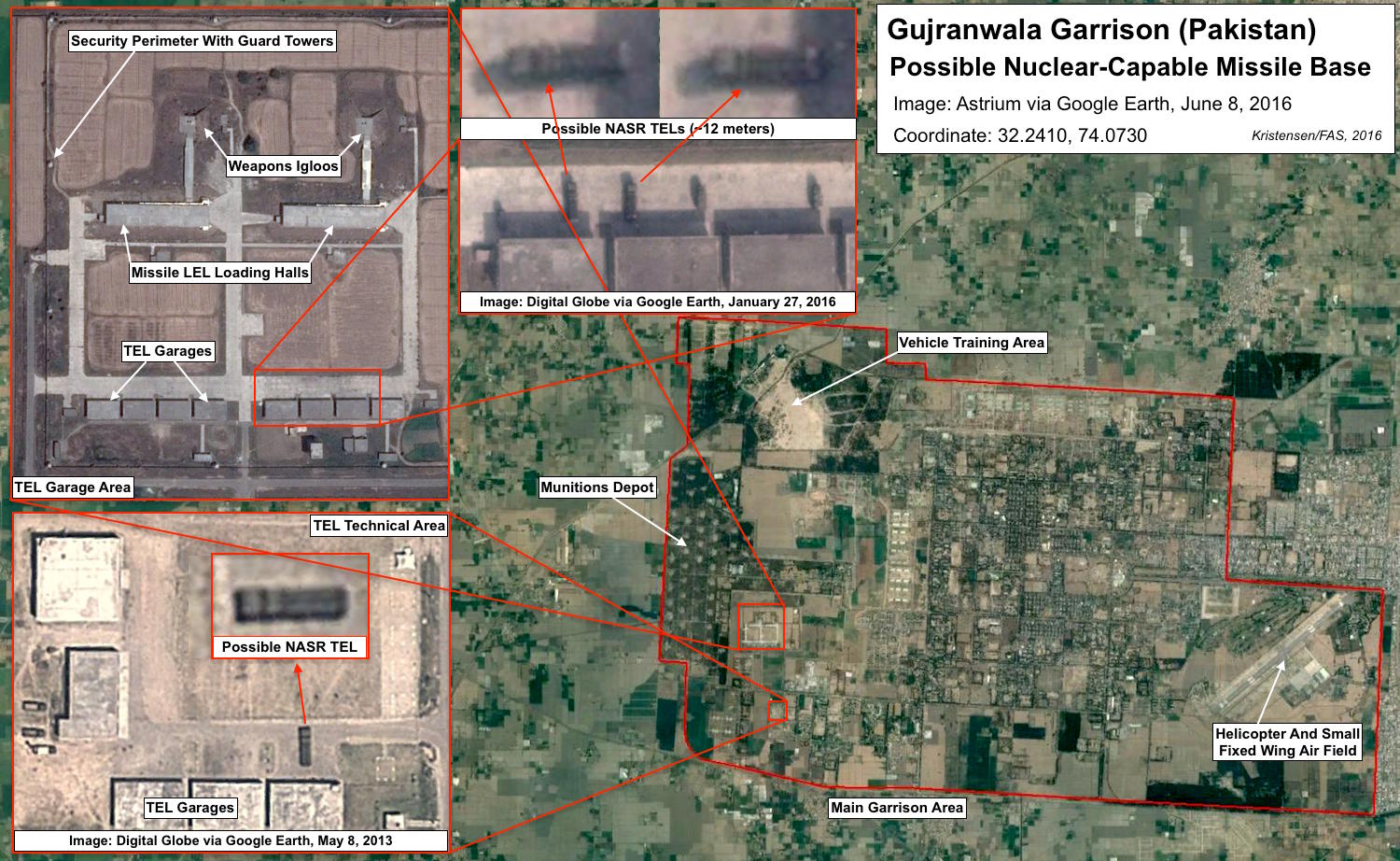
Gujranwala Garrison appears to be a base for the NASR tactical nuclear-capable launcher.
Several trucks have been seen on the satellite pictures that strongly resemble the NASR short-range missile launcher. It is impossible to identify the launchers with certainty due to the relatively poor quality of the pictures (the launchers could potentially also be multiple rocket launchers), but the resemblance is strong with a drivers cabin, a power and hydraulics unit, and a twin box launcher seen on NASR test launch photos published by the Pakistan military. The range of the NASR is equal to the base’s distance from the Indian border.
Khuzdar Garrison: Of the missile garrisons located so far, the Khuzdar Garrison some 220 kms (136 miles) west of Sukkur in south-east Balochistan Province is the one located (27.7222, 66.6241) the farthest from the Indian border (295 kms or 183 miles). The base is split in two sections: a northern section and a southern section (where the TELs are based).
Possible launchers have not been seen and identified in Khuzdar photos, but the TEL garages are longer than at all the other bases except the Sargodha Garrison. This could potentially be a base for Shaheen-2 medium-range missile launchers.
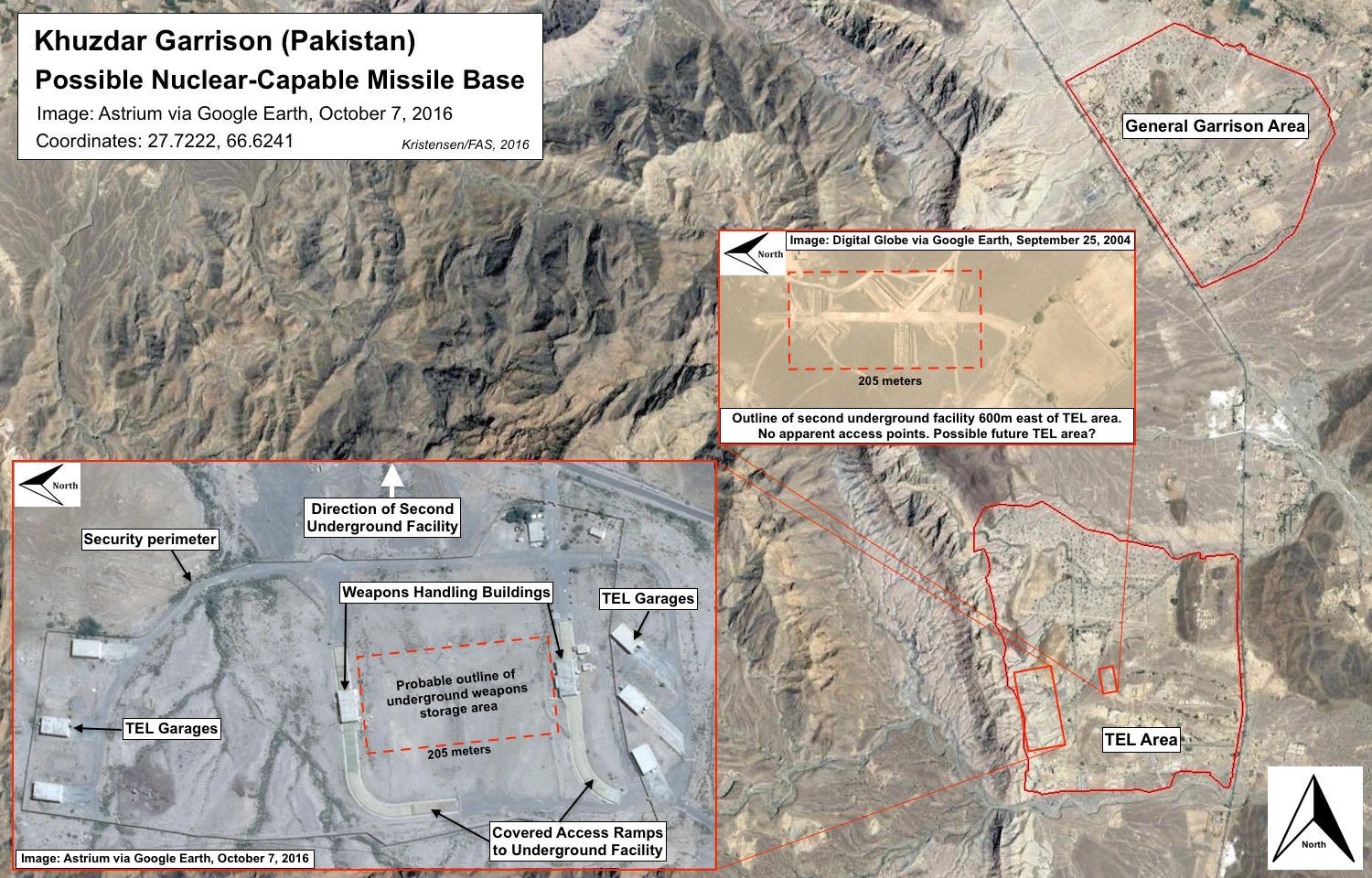
The Khuzdar Garrison might deploy Shaheen-2 launchers.
The TEL area includes what appears to be an underground facility similar to the one identified at the Akro Garrison. It consists of two buildings on covered access ramps that probably provide TEL access to an underground weapons storage and handling facility.
Khuzdar appears to also have a second underground facility approximately 600 meters (1,800 feet) east of the TEL area. This facility has roughly the same overall dimensions as the suspected underground facility between the access ramps inside the TEL area, but the second facility has no TEL facilities on top of it and does not appear to have clear access points. One potential possibility is that this facility may be intended for a second TEL area in the future.
Pano Aqil Garrison: The Pano Aqil Garrison is split up in several sections that cover a combined area of nearly 20 square kms (7.7 square miles). This includes the main garrison area, a TEL area (27.8328, 69.1575), a munitions depot, an airfield, and a shooting range. The base is located approximately 80 kms (50 miles) from the Indian border in the northern part of the Sindh Province.
The TEL area is located 1.8 kms (1.2 miles) northeast of the main garrison and includes five TEL garages (a sixth is under construction) and a service building. At the north end of the facility are located a weapons storage igloo and a weapons handling hall. The layout of the TEL area is similar to the Gujranwala Garrison (which appears to have twice the capacity). The five TEL garages can potentially hold 25 TELs although some of the spaces are probably used by support vehicles.
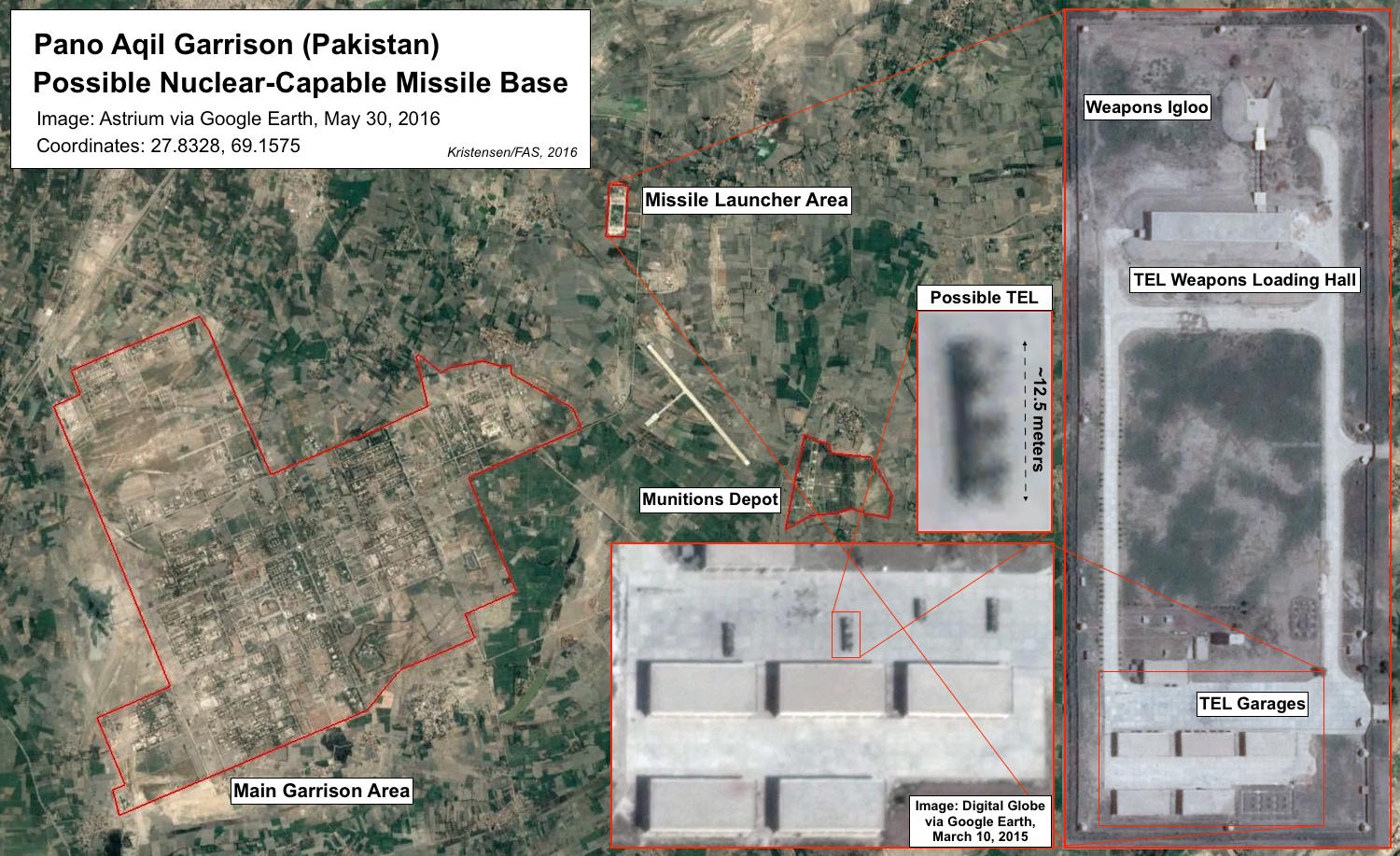
The Pano Aqil Garrison has a remote TEL area.
Identification of TEL type is difficult due to the relatively poor quality of the satellite pictures, but it could potentially be NASR, Shaheen-1 or Ghaznavi short-range missile launchers.
Sargodha Garrison: The large munitions storage depot at Sargodha has long been rumored to include TEL garages. The facilities date back to the mid-1990s when Pakistan was first reported to have acquired M-11 missiles from China (DF-11 or CSS-7), which was used to produce what is now known as Pakistan’s Ghaznavi and Shaheen-1 short-range ballistic missiles. But the garages (31.9722, 72.6838) at Sargodha are nearly twice the size that would be needed by short-range Ghaznavi and Shaheen-1 launchers and seem better sized for medium-range Ghauri or Shaheen-2 launchers. There appear to be 10 TEL garages plus two garages with different dimensions that might be used for maintenance.
Yet the Sargodha complex has less of the type of infrastructure seen at other potential TEL bases. Much of the infrastructure seen might be used by personnel that maintain the large weapons depot itself. Whatever the large garages are used for, they are currently being upgraded and additional infrastructure is being added.
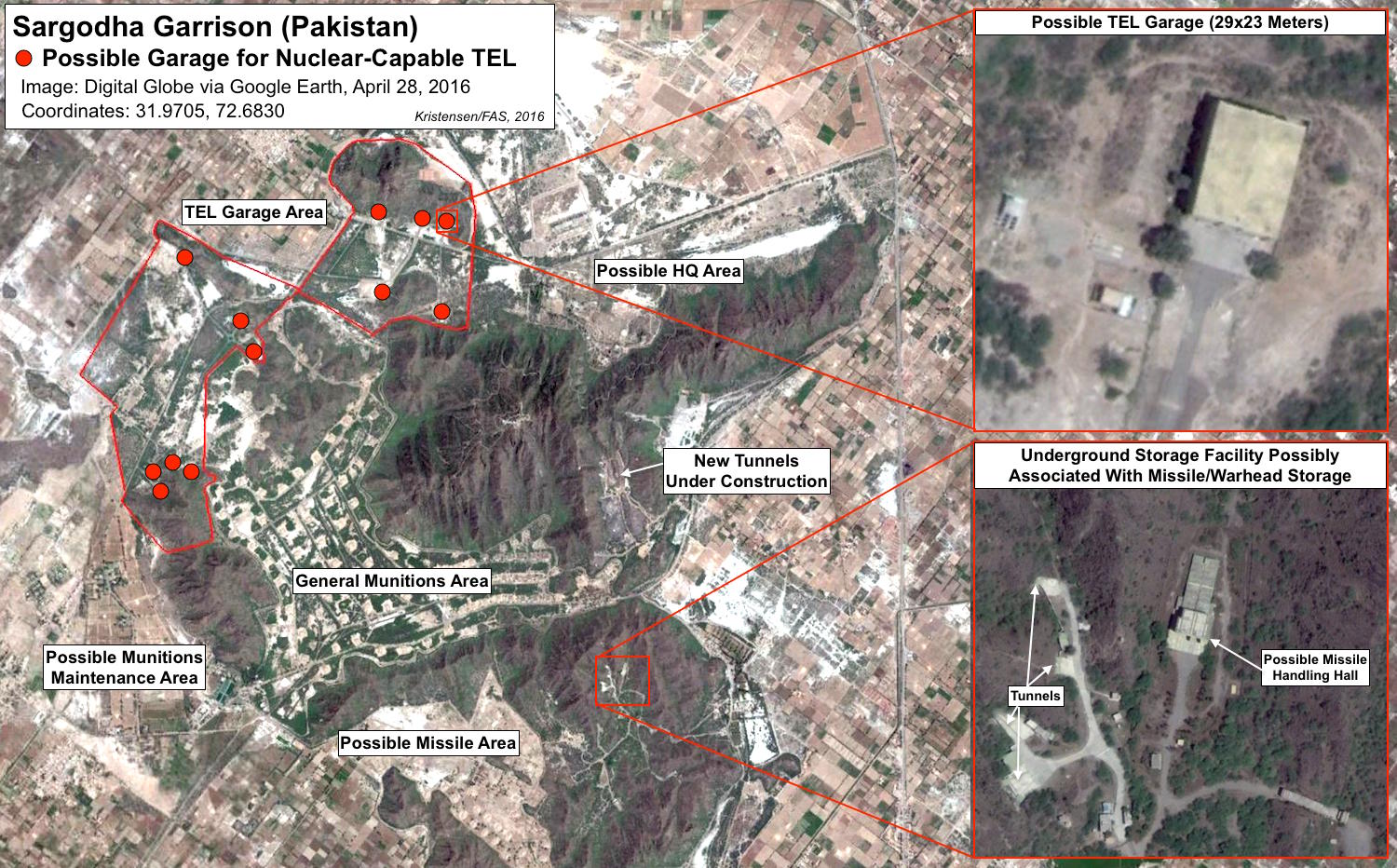
The Sargodha Garrison has large garages and underground facilities.
The Sargodha complex also includes several underground facilities, including a section with two large buildings that could potentially be missile handling halls. Additional tunnels are under construction.
National Development Complex: Several of the TEL types seen or suspected at the different missile garrisons are assembled at the National Development Complex (sometimes called National Defense Complex), or NDC. It consists of a string of facilities scattered across the Kala-Chitta Mountain Range west of Islamabad. But the heart of the complex is the TEL assembly section north of Fateh Jang (33.6292, 72.7106). NDC reportedly emerged in the mid-1990s to produce Gazhnavi and Shaheen-1 short-range ballistic missiles based on technology supplied by China.
Since then NDC has expanded considerably to include facilities west and east of the central TEL assembly area. The central area has expanded considerably since 2003, with the addition of a TEL truck assembly facility as well as three large high-bay TEL assembly halls for mounting missile compartments onto TEL trucks. For the past ten years, these facilities have been busy producing Shaheen-2 medium-range ballistic missile launchers and Babur ground-launched cruise missile launchers.
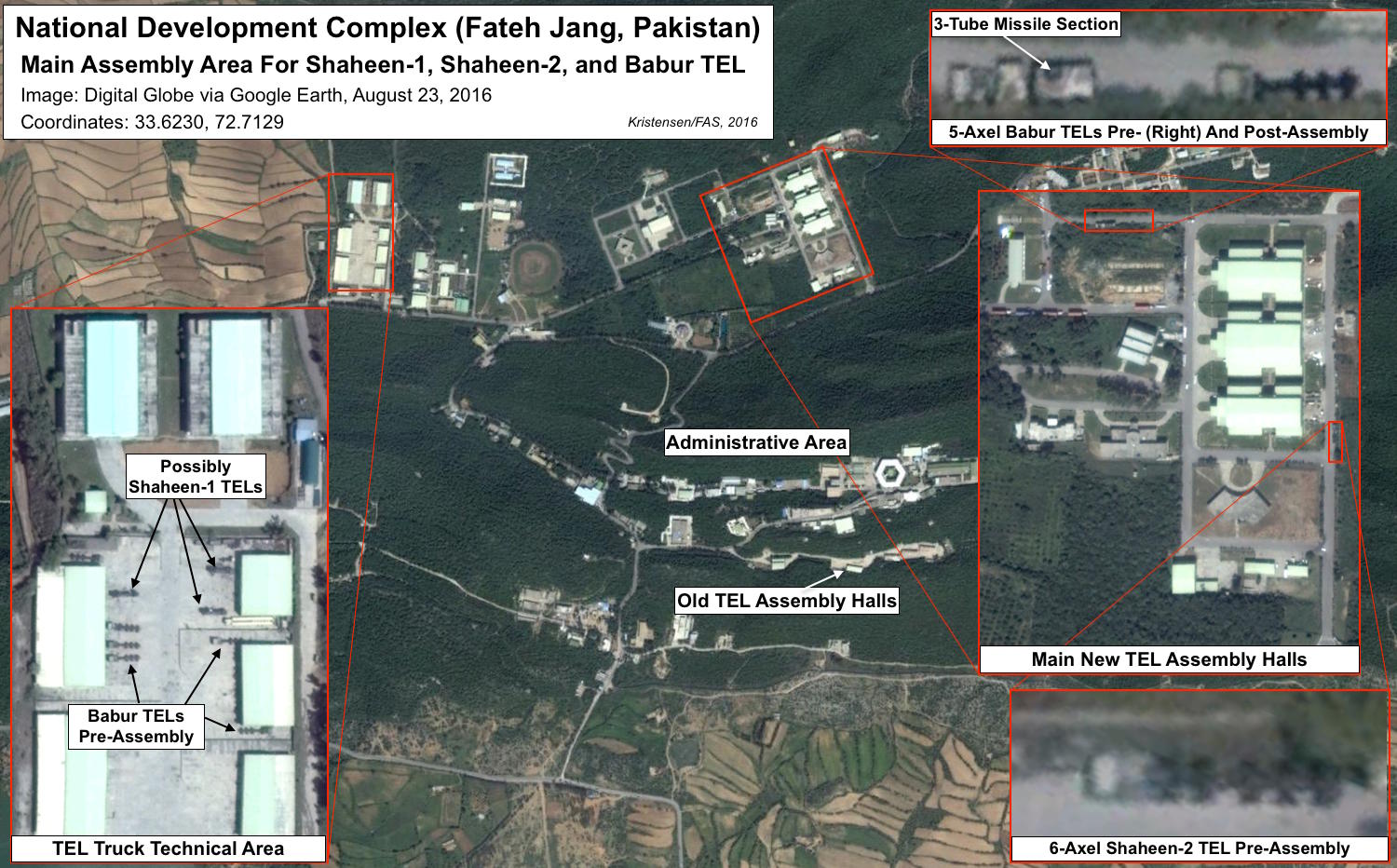
The National Development Complex assembles Shaheen and Babur missile launchers.
Satellite pictures give an example of the flow of production of different TEL types at NDC and also provide valuable reference points for comparing dimensions of TELs seen at individual missile garrisons. Several pictures from 2016, for example, show both 6-axel Shaheen-2 TELs and 5-axel Babur TELs, and possibly also 4-axel Shaheen-1 TELs, in the process of assembly or maintenance. The 8-axel Shaheen-3 TEL has not yet been seen as this weapon system is still very early in production and not yet operationally deployed.
Air Bases
Pakistan has a large number of air bases but only a small number is thought to be involved in the nuclear mission. This includes bases with Mirage and F-16 fighter-bombers. United States officials have stated that F-16s were sold to Pakistan on the conditions that they could not be uses to deliver nuclear weapons, but other sources have indicated that some of the planes were converted nonetheless. French-produced Mirage aircraft are widely assumed to be equipped to deliver the Ra’ad air-launched cruise missile.
Masroor Air Base: This base is located (24.8855, 66.9280) west of the city of Karachi and has long been suspected of serving a role in Pakistan’s airborne nuclear deterrent. The base is home to the 32nd Fighter Wing with Mirage fighter-bombers and is located only 5 kms (3 miles) from a potential nuclear weapons storage site (24.9429, 66.9083).
Over the past decade, unique facilities have been construction at Masroor Air Base that might potentially form part of Pakistan’s nuclear posture. This includes a large underground facility that is located inside a high-security area. The purpose of the facility has not been confirmed and could potentially also involve command and control. Yet the facility is clearly unique compared with other Air Bases and might potentially serve as an underground nuclear weapons storage and handling facility. (Update: the underground facility is possibly a command center.)
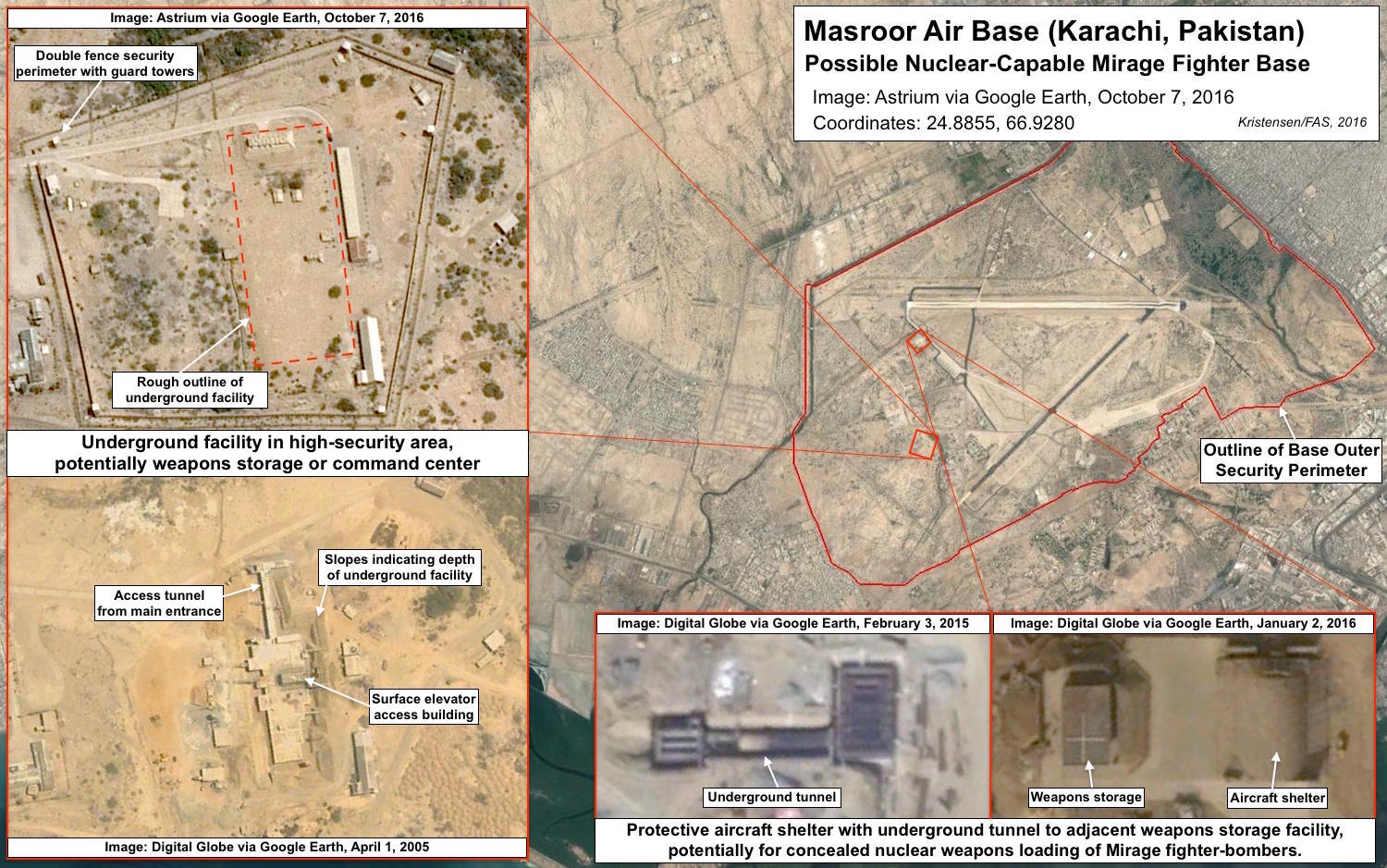
Masroor Air Base includes unique underground facilities.
Another unique facility at Masroor Air Base is a hardened aircraft shelter connected by an underground tunnel to what appears to be a weapons storage facility. The purpose of this facility (first spotted by https://twitter.com/rajfortyseven) is unknown but could potentially be designed to enable concealed nuclear weapons loading of Mirage fighter-bombers.
It should be emphasized that despite the interesting features of some of the facilities at Masroor Air Base, there is no official publicly available information that explicitly identifies them as nuclear.
Mushaf Air Base: One of Pakistan’s oldest suspected nuclear-capable air bases is Mushaf Air Base located (32.0431, 72.6710) near Sargodha in the Punjab Province. The base is the home of the 38th Wing with F-16 squadrons that have long been suspected of forming part of Pakistan’s air-borne nuclear deterrent.
One pair of hardened aircraft shelters at the base are located inside an area with additional security perimeter but there is little visible evidence of nuclear facilities at the base. The munitions storage area shows no unique structures that suggest a nuclear weapons storage role.
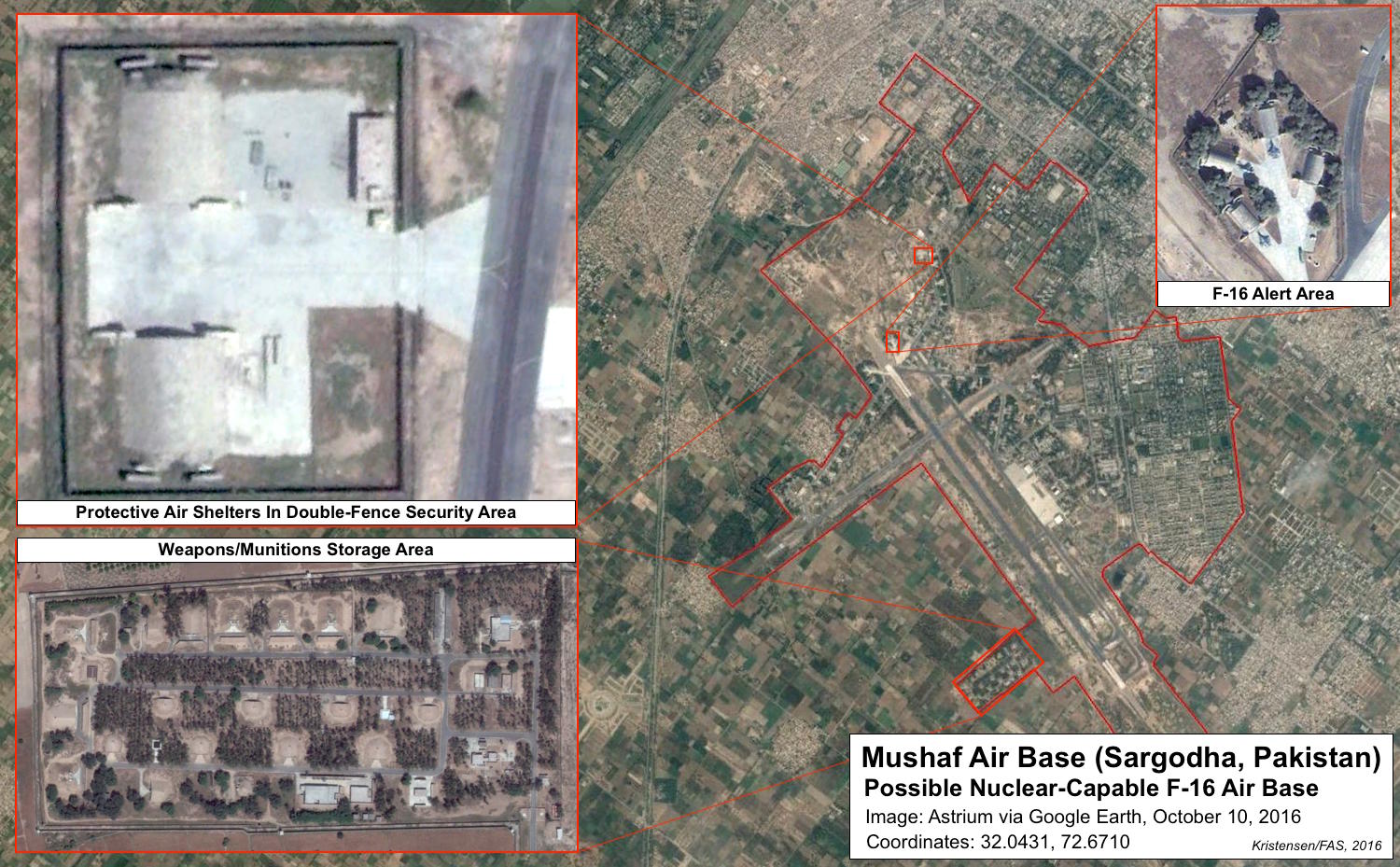
Mushaf Air Base has long been rumored to have a nuclear role.
Instead, nuclear bombs for the F-16s at Mushaf Air Base might be stored at the nearby Sargodha weapons storage facility less than 10 kms (6 miles) to the south.
Others Air Bases: There are a couple of other Mirage and F-16 Air Bases that could potentially also serve a role as part of Pakistan’s airborne nuclear strike mission. This includes the Mirage-equipped base at Rafiqui (30.7580, 72.2822), which has been upgrade over the past three years. The F-16 base at Shahbaz (28.2825, 68.4506) has been upgraded considerably to accommodate the new F-16s (Block 52).
These and other bases could potentially serve a dispersal bases for Mirage and F-16 nuclear-capable bombers. But there is little visible physical evidence to suggest they serve a nuclear role. Likewise, Kamra (Minhas) Air Base (33.8697, 72.4004) has often been suspected to have a nuclear role but appears to serve as conversion facility for aircraft.
Conclusions and Implications
Commercial satellite pictures provide new information about Pakistan’s emerging nuclear weapons posture that includes missile garrisons for short-range nuclear-capable missiles, unique underground facilities potentially intended for nuclear weapons storage, and air bases with possible nuclear-related facilities.
The tactical nuclear-capable launchers do not present a strategic threat to India due to their short range, but their introduction into the Pakistani armed forces raises important questions about early dispersal of nuclear warheads and launch authority in a crisis as well as potential earlier use of nuclear weapons in a conflict with India.
We estimate that Pakistan currently has a stockpile of 130-140 nuclear warheads and is building more. But we also take note of statements by some Pakistan officials that the country might not intend to continue to increase it arsenal indefinitely but may soon reach the goal for the size of its full-spectrum deterrent. Whether and when that will happen remains to be seen. For now the Pakistani arsenal is in a dynamic phase.
Additional Information:
- FAS Nuclear Notebook: Pakistani Nuclear Forces, 2016
- Pakistan’s Strategic Nuclear and Missile Industries
This publication was made possible by a grant from the New Land Foundation and Ploughshares Fund. The statements made and views expressed are solely the responsibility of the author.
Will Trump Be Another Republican Nuclear Weapons Disarmer?
By Hans M. Kristensen
Republicans love nuclear weapons reductions, as long as they’re not proposed by a Democratic president.
That is the lesson from decades of US nuclear weapons and arms control management.
If that trend continues, then we can expect the new Donald Trump administration to reduce the US nuclear weapons arsenal more than the Obama administration did.
What? I know, it sounds strange but the record is very clear: During the post-Cold War era, Republication administrations have – by far – reduced the US nuclear weapons stockpile more than Democratic administrations (see graph below).

Even if we don’t count numbers of weapons (because arsenals have gotten smaller) but only look at by how much the nuclear stockpile was reduced, the history is clear: Republican presidents disarm more than Democrats (see graph below).

It’s somewhat of a mystery. Because Democratic presidents are generally seen to be more likely to propose nuclear weapons reductions. President Obama did so repeatedly. But when Democratic presidents have proposed reductions, the Republican opposition has normally objected forcefully. Yet Republican lawmakers won’t oppose reductions if they are proporsed by a Republican president.
Conversely, Democratic lawmakers will not opposed Republican reductions and nor will they oppose reductions proposed by a Democratic president.
As a result, if the Republicans control both the White House and Congress, as they do now after the 2016 election, the chance of significant reductions of nuclear weapons seems more likely.
Whether Donald Trump will continue the Republication tradition remains to be seen. US-Russian relations are different today than when the Bush administrations did their reductions. But both countries have far more nuclear weapons than they need for national security. And Trump would be strangely out of tune with long-held Republican policy and practice if he does not order a substantial reduction of the US nuclear weapons stockpile.
Perhaps he should use that legacy to try to reach an agreement with Russia to continue to reduce US and Russia nuclear arsenals to the benefit of both countries.
Further reading: Status of World Nuclear Forces
This publication was made possible by a grant from the New Land Foundation and Ploughshares Fund. The statements made and views expressed are solely the responsibility of the author.
Human Factors in Verifying Warhead Dismantlement
Arms control agreements that envision the verified dismantlement of nuclear weapons require the availability of suitable technology to perform the verification. But they also depend on the good faith of the participants and a shared sense of confidence in the integrity of the verification process.
An exercise in demonstrated warhead dismantlement showed that such confidence could be easily disrupted. The exercise, sponsored by the United States and the United Kingdom in 2010 and 2011, was described in a recent paper by Los Alamos scientists. See Review of the U.S.-U.K. Warhead Monitored Dismantlement Exercise by Danielle Kristin Hauck and Iain Russell, Los Alamos National Laboratory, August 4, 2016.
Participants played the roles of the host nation, whose weapons were to be dismantled, and of the monitoring nation, whose representatives were there to verify dismantlement. Confusion and friction soon developed because “the host and monitoring parties had different expectations,” the authors reported.
“The monitoring party did not expect to justify its reasons for performing certain authentication tasks or to justify its rationale for recommending whether a piece of equipment should or should not be used in the monitoring regime. However, the host party expected to have an equal stake in authentication activities, in part because improperly handled authentication activities could result in wrongful non-verification of the treaty.”
“Attempts by the host team to be involved in the authentication activities, and requests for justifications of monitoring party decisions felt intrusive and controlling. Monitoring party rebuffs to the host team reduced the host’s confidence in the sincerity of the monitoring party for cooperative monitoring.”
What emerged is that verified dismantlement of nuclear weapons is not simply a technical problem, though it is also that.
New START Data Shows Russian Warhead Increase Before Expected Decrease
By Hans M. Kristensen
The latest set of so-called New START treaty aggregate data published by the U.S. State Department shows that Russia is continuing to increase the number of nuclear warheads it deploys on its declining inventory of strategic launchers.
Russia now has 259 warheads more deployed than when the treaty entered into force in 2011.
Rather than a nuclear build-up, however, the increase is a temporary fluctuation cause by introduction of new types of launchers that will be followed by retirement of older launchers before 2018. Russia’s compliance with the treaty is not in doubt.
In all other categories, the data shows that Russia and the United States continue to reduce the overall size of their strategic nuclear forces.
Strategic Warheads
The aggregate data shows that Russia has continued to increase its deployed strategic warheads since 2013 when it reached its lowest level of 1,400 warheads. Russian strategic launchers now carry 396 warheads more.
Overall, Russia has increase its deployed strategic warheads by 259 warheads since New START entered into force in 2011. Although it looks bad, it has no negative implications for strategic stability.
The Russian warhead increase is probably a temporary anomaly caused primarily by the fielding of additional new Borei-class ballistic missile submarines (SSBNs). The third boat of the class deployed to its new base on the Kamchatka Peninsula last month, joining another Borei SSBN that transferred to the Pacific in 2015.
The United States, in contrast, has continued to decrease its deployed strategic warheads. It dipped below the treaty limit in September 2015 but has continued to decrease its deployed warheads to 1,367 deployed strategic warheads
Overall, the United States has decreased its deployed strategic warheads by 433 since New START entered into force in February 2011.
As a result, the disparity in Russian and U.S. deployed strategic warheads is now greater than at any previous time since New START entered into force in 2011: 429 warheads.
It’s important to remind that the counted deployed strategic warheads only represent a portion of the two countries total warhead inventories; we estimate Russia and the United States each have roughly 4,500 warheads in their military stockpiles. The New START treaty only limits how many strategic weapons can be deployed but has no direct effect on the size of the total nuclear stockpiles.

The Russian increase in deployed strategic warheads is temporary due to fielding of several new Borei-class ballistic missile submarines. This picture shows the Vladimir Monomakh arriving at the submarine base near Petropavlovsk on September 27, 2016.
Strategic Launchers
The aggregate data shows that both Russia and the United States continue to reduce their strategic launchers.
Russia has been below the treaty limit of 700 deployed strategic launchers since New START entered into force in 2011. Even so, it continues to reduce its strategic launchers. Thirteen deployed launchers have been removed since March 2016 and Russia overall now has 13 launchers fewer than in 2011.
Russia will have to dismantle another 47 launchers to meet the limit of 800 deployed and non-deployed launchers by February 2018. Those launchers will likely come from retirement of the remaining Delta III SSBNs, retirement of additional Soviet-era ICBMs, and destruction of empty excess ICBM silos.
The United States is not also for the first time below the limit for deployed strategic launchers. The latest data lists 681 launchers deployed, a reduction of 60 compared with March 2016. The reduction reflects the ongoing work to denuclearize excess B-52H bombers, deactivate four excess launch tubes on each SSBN, and remove ICBMs from 50 excess silos.
The United States still has a considerable advantage in deployed strategic launchers: 681 versus Russia’s 508. But the disparity of 173 launchers is smaller than it was six months ago. The United States will need to dismantle another 48 launchers to meet the treaty’s limit of 800 deployed and non-deployed strategic launchers by February 2018.
Strategic Context
The ongoing implementation of the New START treaty is one of the only remaining bright spots on the otherwise tense and deteriorating relationship between Russia and the United States. Despite the current increase of Russian deployed strategic warheads, which is temporary and will be followed by retirement of older systems in the next few years that will reduce the count, Russian compliance with the treaty by 2018 is not in doubt. And both countries continue to reduce their deployed and non-deployed strategic launchers.
In fact, the temporary warhead increase seems to be of little concern to U.S. military planners. DOD concluded in 2012 that Russia “would not be able to achieve a militarily significant advantage by any plausible expansion of its strategic nuclear forces, even in a cheating or breakout scenario under the New START Treaty…”
Equally important are the ongoing onsite inspections and notifications between the United States and Russia. The two countries have each carried out 103 inspections and exchanged 11,817 notifications since the treaty entered into force in 2011. These activities are increasingly important confidence-building measures.
Yet the modest reductions under the treaty must also be seen in the context of the extensive nuclear weapons modernization programs underway in both countries. Although these programs do not constitute a buildup of the overall nuclear arsenal, they are very comprehensive and reaffirm the determination by both Russia and the United States to retain large offensive nuclear arsenals at high levels of operational readiness.
Although those forces are significantly smaller than the arsenals that existed during the Cold War, they are nonetheless significantly larger than the arsenals of any other nuclear-armed state.
Moreover, New START contains no sub-limits, which enables both sides to take advantage of loopholes. Whereas the now-abandoned START II treaty banned multiple warheads (MIRV) on ICBMs, the New START treaty has no such limits, which enables Russia to incorporate MIRV on its new ICBMs and the United States to store hundreds of non-deployed warheads for re-MIRVing of its ICBMs. Russia is developing a new “heavy” ICBM with MIRV and the next U.S. ICBM (GBSD) will be capable of carrying MIRV as well.
Similarly, the “fake” bomber count of attributing only one deployed strategic weapon per bomber despite its capacity to carry many more has caused both sides to retain large inventories of non-deployed weapons to retain a quick upload capability with many hundreds of long-range nuclear cruise missiles. And both sides are developing new nuclear-armed cruise missiles.
How the two countries justify such large arsenals is somewhat of a mystery but seem to be mainly determined by the size of the other side’s arsenal. According to the U.S. State Department, the New START “limits are based on the rigorous analysis conducted by Department of Defense planners in support of the 2010 Nuclear Posture Review.”
Yet a recent GAO analysis of the 2010 NPR force structure found that “DOD officials were unable to provide us documentation of the NPR’s analysis of strategic force structure options that were considered.” Instead, STRATCOM, the Air Force and the Navy conducted their own analysis of options, which were discussed at senior-level meetings but not documented.
Both sides can easily reduce their nuclear forces further and increase security, reduce insecurity, and save money while doing so. Possible steps include: a five-year extension of the New START Treaty, lowering the limits of the existing treaty by one-third while maintaining the inspection regime, and taking unilateral steps to reduce the nuclear weapons modernization programs.
Additional information:
- Status of world nuclear forces
- FAS Nuclear Notebook: US nuclear forces 2016
- FAS Nuclear Notebook: Russia nuclear forces 2016
This publication was made possible by a grant from the New Land Foundation and Ploughshares Fund. The statements made and views expressed are solely the responsibility of the author.
Nuclear Weapons Secrecy Policy Relaxed, a Bit
The fact that a now-retired nuclear weapon was once located at a now-closed location in the United States shall no longer be considered classified information, the Department of Defense announced last week.
This may seem so trivial and insignificant as to be hardly worth deciding or announcing, but it could have positive practical consequences for current and future declassification efforts.
“The repeated discoveries of this kind of [information] in numerous records [have] impeded the prompt declassification of many documents,” the National Declassification Center said last week, praising the move.
So with the categorical declassification of such information, the declassification of some historical records should now be facilitated and accelerated.
“Secrecy itself is more dangerous than the possession of atomic weapons,” said Edward Teller in a 1989 presentation at Lawrence Livermore National Laboratory. The Department of Energy posted a transcript of his remarks last week.
Increasing Nuclear Bomber Operations
CBS’s 60 Minutes program Risk of Nuclear Attack Rises described that Russia may be lowering the threshold for when it would use nuclear weapons, and showed how U.S. nuclear bombers have started flying missions they haven’t flown since the Cold War: Over the North Pole and deep into Northern Europe to send a warning to Russian President Vladimir Putin.
The program follows last week’s program The New Cold War where viewers were shown unprecedented footage from STRATCOM’s command center at Omaha Air Base in Nebraska.
Producer Mary Welch and correspondent David Martin have produced a fascinating and vital piece of investigative journalism showing disturbing new developments in the nuclear relationship between Russia and the United States.
They were generous enough to consult me and include me in the program to discuss the increasing Cold War and dangerous military posturing.
Nuclear Bomber Operations Context
Just a few years ago, U.S. nuclear bombers didn’t spend much time in Europe. They were focused on operations in the Middle East, Western Pacific, and Indian Ocean. Despite several years of souring relations and mounting evidence that the “reset” with Russia had failed or certainly not taken off, NATO couldn’t make itself say in public that Russia gradually was becoming an adversary once again.
Whatever hesitation was left changed in March 2014 when Vladimir Putin sent his troops to invade Ukraine and annexed Crimea. The act followed years of Russian efforts to coerce the Baltic States, growing and increasingly aggressive military operations around European countries, and explicit nuclear threats against NATO countries getting involved in the U.S. ballistic missile defense system.
Granted, NATO may not have been a benign neighbor, with massive expansion eastward of new members all the way up to the Russian border, and a consistent tendency to ignore or dismiss Russian concerns about its security interests.
But whatever else Putin might have thought he would gain from his acts, they have awoken NATO from its detour in Afghanistan and refocused the Alliance on its traditional mission: defense of NATO territory against Russian aggression. As a result, Putin will now get more NATO troops along his western and southern borders, larger and more focused military exercises more frequently in the Baltic Sea and Black Sea, increasing or refocused defense spending in NATO, and a revitalization of a near-slumbering nuclear mission in Europe.
Six years ago the United States was this close to pulling its remaining non-strategic nuclear weapons out of Europe. Only an engrained NATO nuclear bureaucracy aided by the Obama administration’s lack of leadership prevented the withdrawal of the weapons. Russia has complained about them for years but now it seems very unlikely that the modernization of the F-35A with the B61-12 guided bomb can be stopped. The weapons might even get a more explicit role against Russia, although this is still a controversial issue for some NATO members.
But the U.S. military would much prefer to base the nuclear portion of its extended deterrence mission in Europe on strategic bombers rather than the short-range fighter-bombers forward deployed there. The non-strategic nuclear weapons are far too controversial and vulnerable to the myriads of political views in the host countries. Strategic bombers are free of such constraints.
A New STRATCOM-EUCOM Link
Therefore, even before NATO at the Warsaw Summit this summer decided to reinvigorate its commitment to nuclear deterrence, former U.S. European Command (EUCOM) commander General Philip Breedlove told Congress in February 2015, EUCOM had already “forged a link between STRATCOM Bomber Assurance and Deterrence [BAAD] missions to NATO regional exercises” as part of Operation Atlantic Resolve to deter Russia.
Less than two months later, on April 1, 2015, four nuclear-capable B-52H bombers took of from their bases in the United States and flew across the North Pole and North Sea in a simulated strike exercise against Russia. The bombers proceeded all the way to their potential launch points for air-launched cruise missiles before they returned to the United States. Such an exercise had not been conducted since the late-1980s against the Soviet Union. Combined, the four bombers could have delivered 80 long-range nuclear cruise missiles with a combined explosive power of 800 Hiroshima bombs.
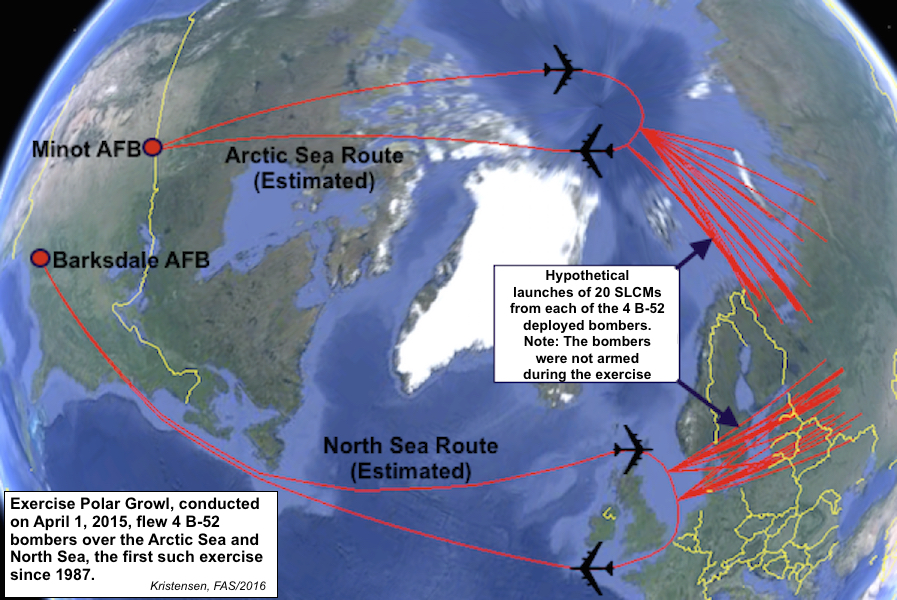
During Exercise Polar Growl on April 1, 2015, four nuclear-capable B-52H bombers flew along two routes into the Arctic and North Sea regions that appeared to simulate long-range strikes against Russia. The four bombers were capable of launching up to 80 nuclear air-launched cruise missiles with a combined explosive power equivalent to 800 Hiroshima bombs. All routes are approximate.
Despite its strategic implications, Polar Growl also had a distinctive regional – even limited – objective because of the crisis in Europe. Planning for such regional deterrence scenarios have taken on a new importance during the past couple of decades and they have become central to current planning because it is in such regional scenarios that the United States believes it is most likely that nuclear weapons could actually be used.
“The regional deterrence challenge may be the ‘least unlikely’ of the nuclear scenarios for which the United States must prepare,” Elaine Bunn, the Deputy Assistant Secretary of Defense for Nuclear and Missile Defense Policy, in 2014 predicted only a few weeks before Russia invaded Ukraine, “and continuing to enhance our planning and options for addressing it is at the heart of aligning U.S. nuclear employment policy and plans with today’s strategic environment.”
Two weeks after the bombers returned from Polar Growl, Robert Scher, the U.S. Assistant Secretary of Defense for Strategy, Plans, and Capabilities, told Congress: “We are increasing DOD’s focus on planning and posture to deter nuclear use in escalating regional conflicts.” This includes “enhanced planning to ensure options for the President in addressing the regional deterrence challenge.” (Emphasis added.)
Nuclear Conventional Integration
Much of this increased planning involves conventional weapons such as the new long-range conventional JASSM-ER cruise missile, but the planning also involves nuclear. In fact, conventional and nuclear appear to be integrating in a way they have done before. This effort was described recently by Brian McKeon, the Principal Deputy Under Secretary of Defense for Policy and Acting Under Secretary of Defense for Policy, during the annual STRATCOM Deterrence Symposium:
In the Department of Defense we’re working to effectively integrate conventional and nuclear planning and operations. Integration is not new but we’re renewing our focus on it because of recent developments and how we see potential adversaries preparing for conflict. This is an area where the focus in Omaha has really led the way and I want to commend Admiral Haney and STRATCOM for being able to shift planning so quickly toward this approach and thinking though conflict. No one wants to think about using nuclear weapons and we all know the principle role of nuclear weapons is to deter their use by others. But as we’ve seen, out adversaries may not hold the same view.
Let me be clear that when I say integration I do not mean to say we have lowered the threshold for nuclear use or would turn to nuclear weapons sooner in a conventional campaign. As we stated in the Nuclear Posture Review, the United States will “only consider the use of nuclear weapons in extreme circumstances to defend the vital interests of the United States or its allies and partners.” The NPR also emphasized the importance of reducing the role of nuclear weapons in our national security strategy, a requirement that has been advanced in our planning consistent with the 2013 Nuclear Employment Guidance, including with non-nuclear strike options.
What I mean by integration is synchronizing our thinking across all domains in a way that maximizes the credibility and flexibility of our deterrent through all phases of conflict and responds appropriately to asymmetrical escalation. For too long, crossing the nuclear threshold was through to move a nuclear conflict out of the conventional dimension and wholly into the nuclear realm. Potential adversaries are exploring ways to cross this threshold with low-yield nuclear weapons to test out resolve, capabilities, and Allied cohesion. We must demonstrate that such a strategy cannot succeed so that it is never attempted. To that end we’re planning and exercising our non-nuclear operations conscious of how they might influence an adversary’s decision to go nuclear.
We also plan for the possibility of ongoing U.S. and Allied operations in a nuclear environment and working to strengthen resiliency of conventional operations to nuclear attack. By making sure our forces are capable of continuing the fight following a limited nuclear use we preserve flexibility for the president. And by explicitly preparing for the implication of an adversary’s limited nuclear use and providing credible options for the President, we strengthen our deterrent and reduce the risk of employment in the first instance.
Regional nuclear scenarios no longer primarily involve planning against what the Bush administration called “rogue states” such as North Korea and Iran, but increasingly focus on near-peer adversaries (China) and peer adversaries (Russia). “We are working as part of the NATO alliance very carefully both on the conventional side as well as meeting as part of the NPG [Nuclear Planning Group] looking at what NATO should be doing in response to the Russian violation of the INF Treaty,” Scher explained.
STRATCOM last updated the strategic nuclear war plan (OPLAN 8010-12) in 2012 and is currently about to publish an updated version that incorporates the changes caused by the Obama administration’s Nuclear Employment Strategy from 2013.
Two months ago, a little over a year after Polar Growl, another bomber strike exercise was launched. This time six bombers (4 B-52s and 2 B-2s) flew closer to Russia and simultaneously over the Arctic Sea, North Sea, Baltic Sea, and North Pacific Ocean. The six Polar Roar sorties required refueling support from 24 KC-135 tankers as well as E4-B Advanced Airborne Command Post and E-6B TACAMO nuclear command and control aircraft.
The routes (see below) were eerily similar to the Chrome Dome airborne alert routes that were flown by nuclear-armed bombers in the 1960s against the Soviet Union.
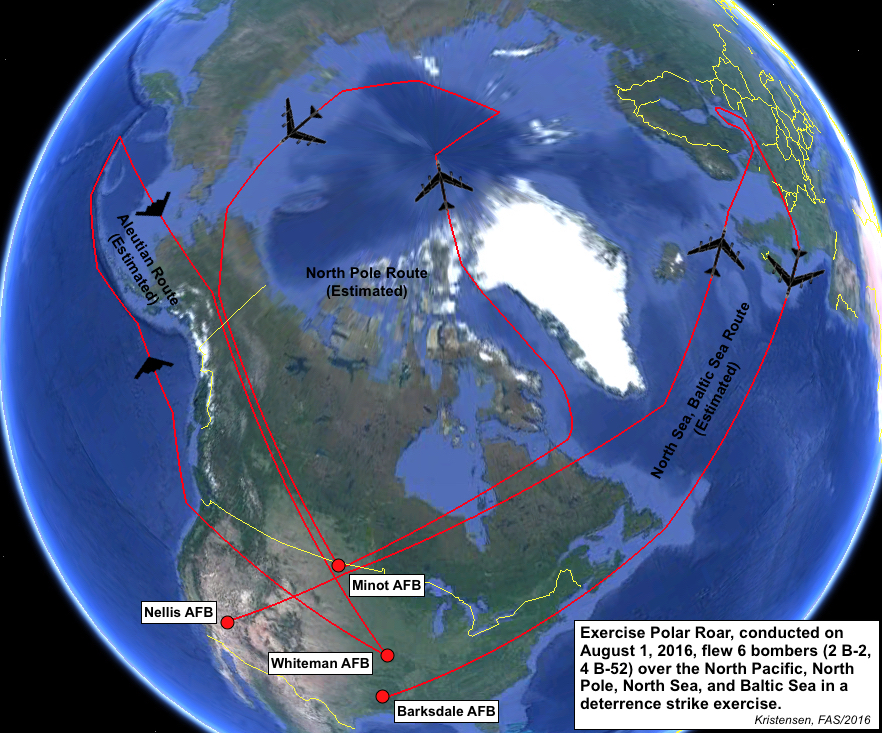
Exercise Polar Roar on August 1, 2016, followed Exercise Polar Growl from 2015 but involved more bombers, both nuclear-capable and conventional-only, and flew closer to Russia and deep into the Baltic Sea. Polar Roar also included B-2 stealth bombers in the North Pacific. All routes are approximate.
This publication was made possible by a grant from the New Land Foundation and Ploughshares Fund. The statements made and views expressed are solely the responsibility of the author.
Seeking Verifiable Destruction of Nuclear Warheads
A longstanding conundrum surrounding efforts to negotiate reductions in nuclear arsenals is how to verify the physical destruction of nuclear warheads to the satisfaction of an opposing party without disclosing classified weapons design information. Now some potential new solutions to this challenge are emerging.
Based on tests that were conducted by the Atomic Energy Commission in the 1960s in a program known as Cloudgap, U.S. officials determined at that time that secure and verifiable weapon dismantlement through visual inspection, radiation detection or material assay was a difficult and possibly insurmountable problem.
“If the United States were to demonstrate the destruction of nuclear weapons in existing AEC facilities following the concept which was tested, many items of classified weapon design information would be revealed even at the lowest level of intrusion,” according to a 1969 report on Demonstrated Destruction of Nuclear Weapons.
But in a newly published paper, researchers said they had devised a method that should, in principle, resolve the conundrum.
“We present a mechanism in the form of an interactive proof system that can validate the structure and composition of an object, such as a nuclear warhead, to arbitrary precision without revealing either its structure or composition. We introduce a tomographic method that simultaneously resolves both the geometric and isotopic makeup of an object. We also introduce a method of protecting information using a provably secure cryptographic hash that does not rely on electronics or software. These techniques, when combined with a suitable protocol, constitute an interactive proof system that could reject hoax items and clear authentic warheads with excellent sensitivity in reasonably short measurement times,” the authors wrote.
See Physical cryptographic verification of nuclear warheads by R. Scott Kemp, et al,Proceedings of the National Academy of Sciences, published online July 18.
More simply put, it’s “the first unspoofable warhead verification system for disarmament treaties — and it keeps weapon secrets too!” tweeted Kemp.
See also reporting in Science Magazine, New Scientist, and Phys.org.
In another recent attempt to address the same problem, “we show the viability of a fundamentally new approach to nuclear warhead verification that incorporates a zero-knowledge protocol, which is designed in such a way that sensitive information is never measured and so does not need to be hidden. We interrogate submitted items with energetic neutrons, making, in effect, differential measurements of both neutron transmission and emission. Calculations for scenarios in which material is diverted from a test object show that a high degree of discrimination can be achieved while revealing zero information.”
See A zero-knowledge protocol for nuclear warhead verification by Alexander Glaser, et al, Nature, 26 June 2014.
But the technology of nuclear disarmament and the politics of it are two different things.
For its part, the U.S. Department of Defense appears to see little prospect for significant negotiated nuclear reductions. In fact, at least for planning purposes, the Pentagon foresees an increasingly nuclear-armed world in decades to come.
A new DoD study of the Joint Operational Environment in the year 2035 avers that:
“The foundation for U.S. survival in a world of nuclear states is the credible capability to hold other nuclear great powers at risk, which will be complicated by the emergence of more capable, survivable, and numerous competitor nuclear forces. Therefore, the future Joint Force must be prepared to conduct National Strategic Deterrence. This includes leveraging layered missile defenses to complicate adversary nuclear planning; fielding U.S. nuclear forces capable of threatening the leadership, military forces, and industrial and economic assets of potential adversaries; and demonstrating the readiness of these forces through exercises and other flexible deterrent operations.”
See The Joint Operating Environment (JOE) 2035: The Joint Force in a Contested and Disordered World, Joint Chiefs of Staff, 14 July 2016.
New FAS Nuclear Notebook: Chinese Nuclear Forces, 2016
By Hans M. Kristensen and Robert S. Norris
China’s nuclear forces are limited compared with those of Russia and the United States. Nonetheless, its arsenal is slowly increasing both in numbers of warheads and delivery vehicles.
In our latest FAS Nuclear Notebook on Chinese nuclear forces published in the Bulletin of the Atomic Scientists, we estimate that China has a stockpile of about 260 nuclear warheads for delivery by a growing diversity of land- and sea-based ballistic missiles and bombers.
Changes over the past year include fielding of the new dual-capable DF-26 road-mobile intermediate-rage ballistic missile, the reported fielding of a new nuclear version (Mod 6) of the DF-21 road-mobile medium-range ballistic missile, more flight-tests of the long-rumored DF-41 road-mobile intercontinental ballistic missile, and the slow readying of the Jin-class (Type 094) nuclear-powered ballistic missile submarines.
China is also modernizing its aging fleet of H-6 bombers, some of which may have a secondary nuclear role.
Although China is still thought to be fielding more DF-31A launchers, the overall number of ICBM launchers has not increased since 2011 but remained at 50-75 launchers. The oldest of these, the liquid-fuel DF-4, apparently has an extra load of missiles but is thought to be close to retirement. None of the new ICBMs are thought to have reloads.
ICBM Exercises and Force Level
Chinese television showed PLARF (PLA Rocket Force) videos of several exercises in late-2015 and early-2016 that included DF-4, DF-21 and DF-31 launchers.
One video showed what was said to be a Rocket Force exercise in northeast China in early 2016 that included a DF-31 launcher. The characteristic outline of the launch site made it possible for us (and many others) to identify the location as a launch unit site of the 816 Brigade at Tonghua in the Jilin province (see image below). The 816 Brigade is thought to be equipped with the DF-21 so the DF-31 exercise probably involved a launch unit on an extended deployment from another brigade.

A DF-31 or DF-31A launcher in exercise on launch pad near Tonghua in northeast China in early-2016. Image: CCTV13.
Although the liquid-fuel DF-4 ICBM is old and very slow as a retaliatory weapon, the single remaining brigade near Lingbao continued to conduct launch exercises in late-2015 and early-2016. One of these involved a roll-out-to-launch exercise from a missile garage of the 801 Brigade near Lingbao in Henan province (see image below). The DF-4 will likely be phased out in the near future.

A DF-4 launch unit near Lingbao held a roll-out-to-launch exercise in late-2015. Image: PLARF via CCTV-13.
Overall the number of Chinese ICBM launchers has been growing slowly since the mid-2000s. The DF-31 and its longer-range version DF-31A have been slowly fielding since 2006 and 2007, respectively, although the DF-31 seems to have stalled after less than 10 launchers. The DF-31A may still be fielding but not much. Since the mid-2000s, the introduction of these two systems has doubled the size of the Chinese ICBM force from around 30 to around 60. The force has been stable since 2011 (see image below).

Chinese ICBM launchers doubled between 2006 and 2011 but have remained steady since. Click to view full size.
There have also been several unconfirmed reports of a new DF-41 ICBM being test-launched, sometimes from rail cars. The Pentagon first predicted fielding of the long-rumored DF-41 in the late-1990s but then dropped references to the weapon system until two years ago when it stated that the missile might be capable of carrying MIRV warheads. Since then several photos of an eight-axel launcher have appeared on the Internet with unconfirmed claims that they showed the DF-41.
Once the DF-41 finally deploys, it will likely result in the retirement of the DF-4 and potentially also the liquid-fuel silo-based DF-5A/B, some of which have recently been equipped to carry MIRV.
DOD projections for the number of Chinese ICBM warheads that could threaten the United States have fluctuated over the years, generally promising too much too soon. Moreover, the projections have been inconsistent about whether they concerned warheads that could reach any part of the United States or just the continental United States. With the addition of MIRV to the DF-5B and potentially also on the future DF-41, the projections could potentially reach approximately 100 warheads in the foreseeable future (see graph below).

US agency projections for Chinese ICBM warheads have promised too much too soon. But with Chinese MIRVing of some ICBMs, the projections could potentially come true. Click to view full size.
IRBM/MRBM Developments
China is also boosting its force of medium- and inter-medium-range ballistic missiles for regional deterrence missions. The most important new development is the introduction of the new DF-26, an intermediate-range dual-capable road-mobile ballistic missile. Sixteen launchers were shown during the 2015 military parade but the system is probably still in its early stages of introduction.
The focus on missiles for regional deterrence missions is particularly clear in the fielding of several conventional versions of the solid-fuel DF-21 MRBM (DF-21C or CSS-5 Mod 4, and DF-21D or CSS-5 Mod 5). But the 2016 DOD report on Chinese military development also reports deployment of a new nuclear version of the DF-21, designated CSS-5 Mod 6. China already operates two older nuclear versions of the DF-21 (DF-21 or CSS-5 Mod 1, and DF-21A or CSS-5 Mod 2). It is unclear if the new Mod 6 version will be deployed alongside the two older versions or if it is intended to replace them.
More than 25 years after the DF-21 first began replacing the liquid-fuel DF-3A medium-range ballistic missile, the transition seems to be complete and the DF-3A finally retired. One of the bases where the transition has been visible is the 810 Brigade launch site near Dengshahe in the Liaoning province of northeast China. Commercial satellite images show the transition from DF-3A in 2003 to the DF-21 in 2014. A satellite image from April 2016 shows three DF-21 launchers positioned on the launch pads along with support vehicles (see image below).
The SSBN Fleet
China’s attempt to build an SSBN fleet has so far resulted in four Jin-class (Type 094) SSBNs entering service. The US Navy says all four are based at the Longpo naval base on Hainan Island, although commercial satellite images have so far only shown three SSBNs at the base simultaneously.
The big question, which has generated lots of Internet rumors and news media articles, is whether the Jin fleet has yet conducted a deterrence patrol with nuclear-tipped JL-2 missiles onboard. We find that highly unlikely given the Chinese leadership’s reluctance to hand out nuclear weapons to the military services in peacetime. It is possible that one or more of the Jin subs have sailed on long voyages far from Chinese waters, but we haven’t seen credible sources reporting actual nuclear deterrent patrols yet.
Another area of speculation is how China will operate its SSBN fleet once it becomes fully operational. Most reports bluntly state that the Jin fleet will provide China with a secure second-strike capability. But that is an overstatement, given the technological, operational, and geographic challenges the Jin fleet faces. The Jin subs are as noisy [/blogs/security/2009/11/subnoise/] as submarines built by the Soviet Union back in the 1970s, the Chinese navy has almost no experience in operating nuclear-armed submarines, and the limited range of the JL-2 requires the submarine to sail far into dangerous waters to be able to hit targets in the United States.
ONI stated in 2015 [http://www.oni.navy.mil/Portals/12/Intel%20agencies/China_Media/2015_PLA_NAVY_PUB_Print.pdf?ver=2015-12-02-081247-687] that, once deployed, the Jin/JL-2 weapon system “will provide China with a capability to strike targets on the continental United States.” But that’s an overstatement. To reach targets on the continental United States, a Jin SSBN with JL-2 SLBMs would have to sail at least 3,600 kilometers (2,200 miles) from its base on Hainan Island into the Pacific Ocean just to be able to target Seattle (see image). Alaska and Guam could be hit from Chinese waters but Hawaii could not. Moreover, to target Washington, DC, a Jin SSBN would have to sail halfway across the Pacific Ocean.

Despite claims by many, including the US Navy, the JL-2 SLBM does not have sufficient range to target the continental United States.
We have analyzed the Chinese SSBN fleet for the past decade and frequently pointed out the tendency to overstate or exaggerate the capability of the Jin-class SSBNs and their missiles. The Jin-class fleet seems more like a work in progress that is intended to build technology and operational experience for the next generation SSBN: the Type 096.
Background: Chinese nuclear forces, 2016 (FAS Nuclear Notebook)
This publication was made possible by a grant from the New Land Foundation and Ploughshares Fund. The statements made and views expressed are solely the responsibility of the author.

